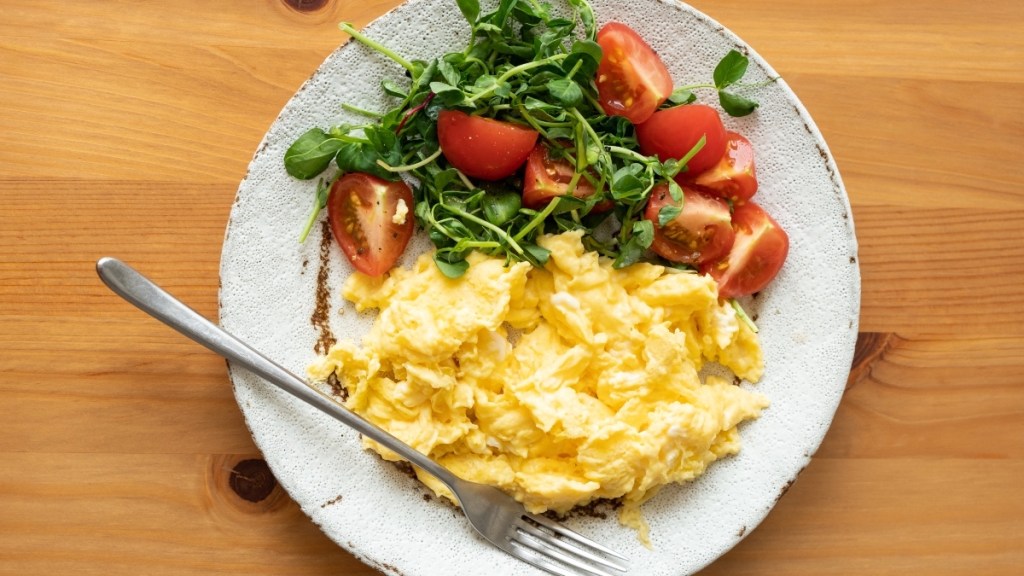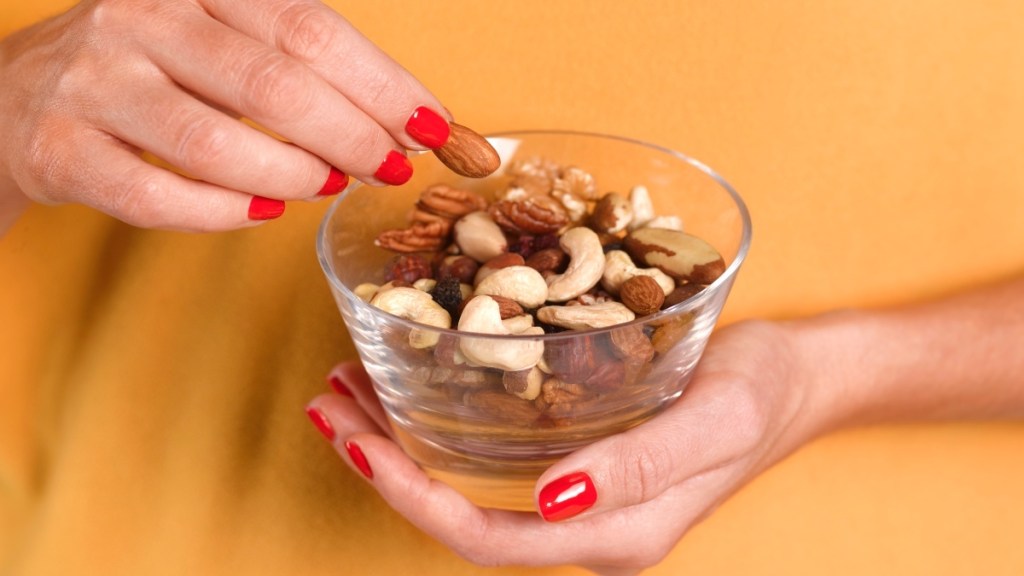These 9 Simple (and Delicious!) Food Swaps Significantly Lower Diabetes Risk, Say MDs
Plus the easy lifestyle tweaks that curb your risk of developing the disease by up to 63%

You already know the importance of warding off type 2 diabetes: The condition can be a lot of work to manage, puts an extra strain on your heart and kidneys and can lead to painful nerve conditions. Still, if your doctor has told you that your blood sugar levels are creeping up, bringing them down out of the danger zone can seem daunting. The good news: Bringing down your blood sugar levels and cutting your risk of developing the disease in half can be as easy as a few simple, tasty food swaps for diabetes. These swaps will also help keep blood sugar levels in check if you’ve already been diagnosed. Read on to see the doctor-recommended swaps that can steady your blood sugar with every delicious bite.
Understanding diabetes
Diabetes is a disease that occurs when your body is unable to process sugar effectively. This means that the level of sugar (aka glucose) in your blood is too high. The most likely reason for high blood glucose levels: Your body is not producing enough insulin, the hormone that transports glucose from your blood into your cells so that it can be used for energy.
There are two types of diabetes: type 1 diabetes and type 2 diabetes. People with type 1 diabetes make little to no insulin, so they need to take insulin every day. Folks with type 2 diabetes, on the other hand, have either stopped making enough insulin or lost the ability to use it properly. While type 1 diabetes is likely genetic, people can develop type 2 diabetes over time.
According to the National Institutes of Health, about 90-95% of diabetes cases are type 2 diabetes. And the condition becomes more common as we age. In fact, type 2 diabetes risk increases up to sixfold between ages 44 and 65, and more than 1 in 3 American adults likely has elevated blood sugar levels. (Click through to learn how warding off diabetes helps prevent heart disease in women and how it can prevent urine that smells like popcorn.)
How diabetes is diagnosed
Diabetes is diagnosed using blood tests that measure your blood glucose levels in a few different ways. The most common type of test is fasting blood glucose test, which is typically taken in the morning after you’ve fasted for 8 hours. Doctors now also diagnose people with prediabetes, or blood sugar levels that are higher than normal but not high enough to be classified as type 2 diabetes.
If you have prediabetes, it is likely to progress to type 2 diabetes without intervention. Fasting blood glucose readings of 99 mg/dL and below are considered normal. Prediabetes is diagnosed when you readings fall between 100 to 125 mg/dL, while diabetes is considered a reading at or above 126mg/dL. Doctors also use A1C levels to diagnose diabetes and prediabetes. (Click through to learn how stopping age-related muscle loss helps ward off insulin resistance, too.)
Related: Reverse Prediabetes Without Depriving Yourself? Yes! Experts Share Their Best Tips
What increases the risk of type 2 diabetes
There are some risk factors for type 2 diabetes that you can’t control, such as your age, your ethnicity and if you have an immediate family member who also has or had type 2 diabetes. But there are also 3 key lifestyle factors that can increase your odds of developing type 2 diabetes:
1. Your weight and waist size
Most of us are carrying around a few extra pounds we’d like to lose. Especially since being overweight can increase the risk of developing diabetes. According to research in The Texas Heart Institute Journal, women with a body mass index (BMI) of 30 or higher (or a 5’4” woman who weighs 175 pounds, for example) have a 28 times greater risk of developing diabetes than women with a BMI of 25 or lower (a 5’4” woman who weighs 145 pounds). What’s more, those with a BMI of 35 or higher (or a 5’4” woman who weighs 205 pounds) have a 93 times greater risk.
Another way to determine your diabetes risk is by measuring your waist circumference. Women with a waist circumference of 35 or more inches have a higher risk of diabetes. Waist circumference may actually be a more direct factor than weight, say experts at the National Institutes of Health. Why? It’s an indirect measurement of the amount of dangerous fat in your abdomen, which increases your diabetes risk.
The good news: The National Institute of Diabetes and Digestive and Kidney Diseases found that losing just 5-7% of your body weight, or 8.75 pounds for a 175-pound woman, may be enough to prevent type 2 diabetes. (Click through to learn how toilet mold can be the first sign of diabetes.)
2. Your activity levels
On hectic days, it can be difficult to squeeze in time for long walks or a trip to the gym. But the downside is that less you move, the higher your risk of developing type 2 diabetes — and not just because of how it might influence your weight. According to a review in Diabetes Care, regular activity improves your muscles’ ability to pull glucose from your blood to use for energy, which keeps your blood sugar levels low.
Physical activity of varying intensity levels has also been found to improve insulin sensitivity for anywhere from 2 to 72 hours after a single session. Fortunately, moving your body is short bursts throughout the day, even just standing up for a few minutes every hour, is just as beneficial as setting aside longer bouts of time for a walk or a resistance training session.
Related: Is Falling Asleep After Eating a Sign of Diabetes? It Can Be — Here’s How To Tell
3. You have prediabetes
If you have prediabetes, you’re more likely to develop type 2 diabetes because your body’s ability to utilize blood glucose and regulate insulin production is already impaired. Taking steps to lose weight and incorporate more activity into your daily routine can help reverse prediabetes, as can making a few simple food swaps for diabetes. (Click to learn how long it takes to reverse prediabetes with a few small lifestyle tweaks, and how warding off diabetes helps prevent vision-clouding cataracts and shingles.)
How food swaps may ward off diabetes
“Decisions about what you eat every day are just as important as taking medication,” says diabetes and metabolism specialist Rekha Kumar, MD, the Chief Medical Officer at Found and an Associate Professor of Clinical Medicine at Weill Cornell Medical College. “When someone has type 2 diabetes, these decisions are even more critical because the blood sugar is impacted much more easily than in someone without diabetes.”
While eating sugary foods for a few days in a row is not going to elevate your blood sugar levels for good, over time it can have a significant impact. “Diabetes often has a quiet onset,” explains functional medicine practitioner Tamika Henry, MD, Founder of Unlimited Health Institute. “That’s why when people go to the doctor, the diagnosis of diabetes is often an incidental finding. It’s also why paying attention to your daily choices of food and drinks are so important. Because over time, the long-term consequence could be diabetes — especially if there is an underlying family history.” (Click through to discover how a glass of wine with dinner may help ward off diabetes.)
9 food swaps for diabetes
While you can’t control risk factors like family history, making small changes to your diet can go a long way toward warding off diabetes. “Decisions regarding what to eat and drink are choices you do have control over,” says Dr. Henry, who is a fan of the 80:20 rule. She aims to make healthy choices 80% of the time. “No one is expected to be perfect. The key is to have consistency!”
And luckily, you don’t need to overhaul your diet to see results. Making the following food swaps, even just one a day, can help you avoid or reverse type 2 diabetes. The best part: You won’t ever feel deprived!
1. Instead of cereal, savor scrambled eggs
Savoring a hearty egg scramble or a protein-packed smoothie instead of cereal is one of the easiest food swaps you can make to shield against diabetes from the day’s start. “Eating a protein-rich breakfast can set the tone for the day by helping you gain better control over both your blood sugar and insulin levels,” says Dr. Kumar. “The protein helps stabilize blood sugar levels, preventing blood sugar spikes throughout the day. Consuming about 30 grams of protein at breakfast is a good goal.”
The result: According to a study published in the journal Nutrients, starting your day with protein can blunt blood sugar spikes by up to 39%. Plus it primes the pancreas to release proper amounts of blood sugar-balancing insulin throughout the day. A 3-egg omelet or scramble and a piece of toast or an apple with 3 Tbs. of peanut butter will give you 30 grams of protein. (Click through to discover how morning protein can speed weight loss and how protein coffee can help you reach that 30 grams.)

2. Instead of a latte, opt for black coffee
Go ahead and refill your cup of java — as long as you hold the cream and sugar. A study in the Journal of Traditional and Complementary Medicine on the effects of coffee consumption on glucose metabolism suggests that drinking three to four cups of coffee can lower the risk of developing type 2 diabetes by 25%, Dr. Kumar says. “Even people who increased their coffee consumption by one cup per day experienced an 11% decrease in type 2 diabetes risk over the subsequent four years,” she adds.
It works by improving insulin sensitivity, taming inflammation and steadying your blood sugar. The fastest way to get the perks: Take your coffee black. “By forgoing cream and sugar in your coffee, you can prevent a spike in your body’s blood sugar,” Dr. Kumar explains. (Click through to discover how choosing lighter roast coffee can speed weight loss.)
3. Instead of eating milk chocolate, go dark
Rich dark chocolate is more than just delicious. It has a higher concentration of glucose-regulating compounds, plus it won’t spike your blood sugar like milk chocolate can. Cocoa contains beneficial epicatechin monomers that steady insulin release, while its magnesium cuts diabetes risk by up to 47%, according to research out of UNC Chapel Hill.
Dr. Henry’s advice: “Consider a Hu dark chocolate bar. There are no refined sugars, no cane sugar, no sugar alcohols, no erythritol, no soy/gluten, no palm oil, no lecithin, no emulsifiers. They are sweetened with coconut sugar and therefore can potentially lead to less of an increase in sugar as compared to other candy bars.” Just remember to nibble on 1 to 2 pieces rather than indulging in the entire bar in one sitting, Dr. Henry notes. One to try: Hu Simple Dark Chocolate Bar (Buy from iHerb.com, $3.62). (Click through to learn how much caffeine is in different kinds of chocolate.)
4. Instead of romaine lettuce, choose spinach or kale
Next time you making a salad for lunch, trade your usual romaine for a spinach salad. “Dark green leafy greens are higher in fiber and overall more nutrient-dense than lettuce, which can help regulate blood sugar levels,” says Dr. Kumar.
They are also rich in vitamin K-1, a nutrient that helps enhance insulin sensitivity, or the body’s ability to process insulin after you eat something that contains glucose. A study in The American Journal of Clinical Nutrition found that upping your intake of this crucial vitamin can reduce diabetes risk up to 51%.
5. Instead of chips, nosh on nuts
When a craving something salty and crunchy hits, you’re better off noshing on nuts than snacking on chips. Walnuts, cashews, pecans and Brazil nuts, which are all high in magnesium, are your best bet. “Nuts are high in healthy fats, which can be helpful for preventing blood sugar spikes,” Dr. Kumar notes. “And magnesium is shown to improve insulin sensitivity, since intracellular magnesium plays a role in regulating insulin and carbohydrate metabolism.”
(Click through for more specifics on how walnuts can help ward off diabetes and about pecans and diabetes.)

6. Instead of sugar, sweeten with cinnamon
Whether you’re making a bowl of oatmeal or savoring French toast, topping it with a sprinkle of cinnamon or ginger (in place of sugar) can keep diabetes at bay. A study published in Nutrition and Metabolic Insights found that just ½ tsp. of cinnamon blunted blood sugar spikes by up to 29%, an effect comparable to the diabetes drug metformin. That’s thanks to the way the spice’s cinnamaldehyde enhances activity of GLUT1, a protein that keeps blood sugar balanced. (Click through to learn more about how cinnamon can reverse prediabetes and how a type of cinnamon known as saigon cinnamon encourages weight loss.)
Ginger, meanwhile, contains compounds (gingerols and shogaols) that blunt the action of digestive enzymes that turn carbohydrate into glucose. The spice is so effective that just ¾ tsp. of ginger daily lowers fasting blood sugar by 30 points in 90 days, according to a study in Revista Latino-Americana De Enfermagem. “Ginger not only helps with digestion, but is thought to help control elevated insulin levels leading to better blood sugar control,” adds Dr. Henry. (Click through to learn more about the benefits of ginger shots.)
7. Instead of black tea, sip green tea
If you typically drink black tea, try trading your daily cuppa for a green brew instead. According to a study in the Diabetes & Metabolism Journal, sipping 2 to 3 cups of green tea daily lowers your odds of developing diabetes by 33%. That’s because the brew contains polyphenols and polysaccharides that help balance blood sugar, plus play a role in weight control. “Drinking green tea can help with weight” says Dr. Henry. “As a person loses weight, the thought is there is an increase with insulin sensitivity. And that leads to a decrease in blood sugar, thus better control of diabetes.” (Click through to discover a 2-ingredient green tea recipe that speeds slimming and how the chlorogenic acid in coffee can help balance blood sugar.)
8. Instead of parsley, garnish with cilantro
The next time you’re looking for an herb to finish your guacamole, salsa or pesto, sprinkle on fresh cilantro. “The thought is that cilantro helps lower blood sugar levels, can help the role of insulin in diabetics, and also help support the liver,” says Dr. Henry. Indeed, a study in the Journal of Ethnopharmacology suggests that compounds in cilantro suppressed high blood sugar as effectively as some medications. In fact, it works so well that folks with low blood sugar are warned to avoid eating it!

9. Instead of grapes, munch on berries
Keeping fruit in your fridge to snack on is always a good idea. But people looking to keep their blood sugar low might want to swap out grapes, which are higher on the glycemic index, for strawberries, blueberries or raspberries. “Berries are a great naturally-sweet treat that are high in fiber and have a low glycemic index (how fast the sugar spikes) to help prevent blood sugar spikes,” says Dr. Kumar. And according to a Harvard study published in BMJ, folks who eat at least 2 servings of berries a week are 33% less likely to experience elevations in hemoglobin A1C (HbA1c), a measurement of average blood sugar levels, than those who don’t regularly eat the fruit. (Click through to discover the 9 low-glycemic fruits that are safe for diabetics.)
4 lifestyle swaps for diabetes
In addition to food swaps for diabetes, these smart lifestyle swaps can further increase your odds of outsmarting trouble:
1. Instead of a big supper, savor a big lunch
Most of us dig into a hearty supper, but simply fueling up with a bigger lunch can provide big benefits when it comes to curbing diabetes risk. Research from NYU Langone Health found that those who ate 80% of their daily calories within eight hours of waking had lower blood sugar and fewer glucose fluctuations than those who ate half their calories after 4 PM.
“Eating your biggest meal of the day when you are most active makes it easier for your body to regulate your blood sugar,” Dr. Kumar explains. “This is because after lunch, your body likely needs the energy from food to function in its daily activities versus after dinner (since most people are less active in the evening).” The payoff: The researchers say that the reduction in glucose levels is enough to stop prediabetes from progressing to type 2 diabetes.
2. Instead of a long workout, move throughout the day
Getting a daily dose of movement can help keep high blood sugar at bay, but you don’t need to carve out time for a long stroll. Research in the World Journal of Diabetes suggests walking for at least 30 minutes daily (even just 5 minutes at a time) switches on enzymes that help the body use glucose efficiently, lowering diabetes risk by 50%. “Increasing your movement can help to naturally lower your blood sugar levels,” affirms Dr. Kumar. “Your muscles use the sugar for energy so that insulin doesn’t have to work as hard.” (If foot pain makes it hard to stay active, click through to see our best insoles for plantar fasciitis and other foot bothers.)
Tip: Whenever you can, take a short stroll after eating. Check out the video below to see how a 2-minute walk post-meal can keep your blood sugar in check.
3. Instead of using plastic cups, sip from glass
Swapping out your plastic cups for glasses or repurposed mason jars can curb diabetes risk up to 63%. That’s because glass is free of estrogen-mimicking compounds in plastic called phthalates, which cause your body to store fat and disrupt its ability to regulate glucose, say scientists writing in The Journal of Clinical Endocrinology and Metabolism. (Click through to discover how one glass of wine with dinner may be okay for diabetics.)
4. Instead shower, relax in a warm bath
If you have a few extra moments to treat yourself to a steamy soak instead of a shower at the end of the day, you’ll slash your diabetes risk as you unwind. Research in Diabetes, Metabolic Syndrome and Obesity found that soaking in a warm bath for 16 minutes daily lowers your risk of elevated HbAc1 by 31%. The reason: Immersing your body in hot water acts much like exercise to boost blood flow. It shunts glucose into muscles so it doesn’t build up in the bloodstream and cause your levels to spike.

For more ways to steady your blood sugar and dodge diabetes:
Small Lifestyle Tweaks That Can Reverse Prediabetes In 12 Weeks + Power Off Pounds
9 Low-Glycemic Fruits to Consider Adding to Your Diet — Even If You Suffer from Diabetes
“This $6-a-Month Magnesium Supplement Reversed My Diabetes!”
Eating This Popular Snack Before Bed Can Help Balance Blood Sugar and Ward Off Diabetes
This content is not a substitute for professional medical advice or diagnosis. Always consult your physician before pursuing any treatment plan.













